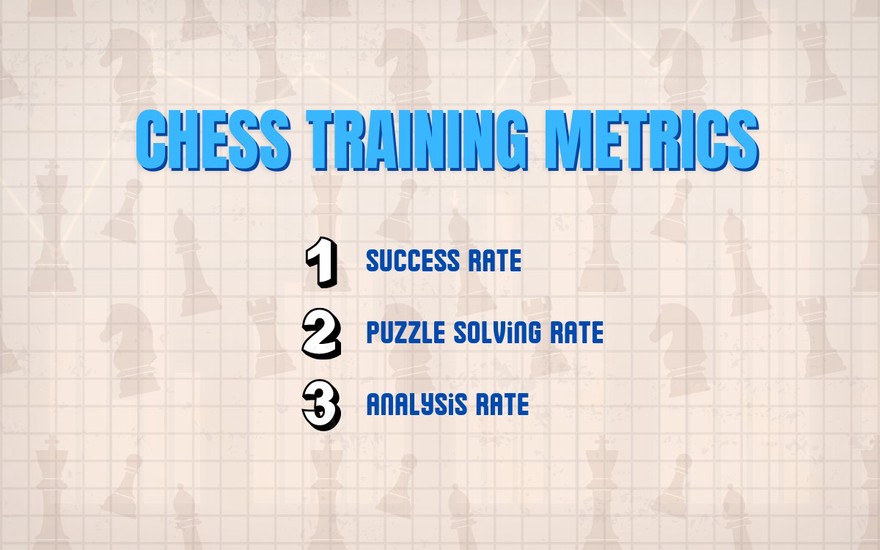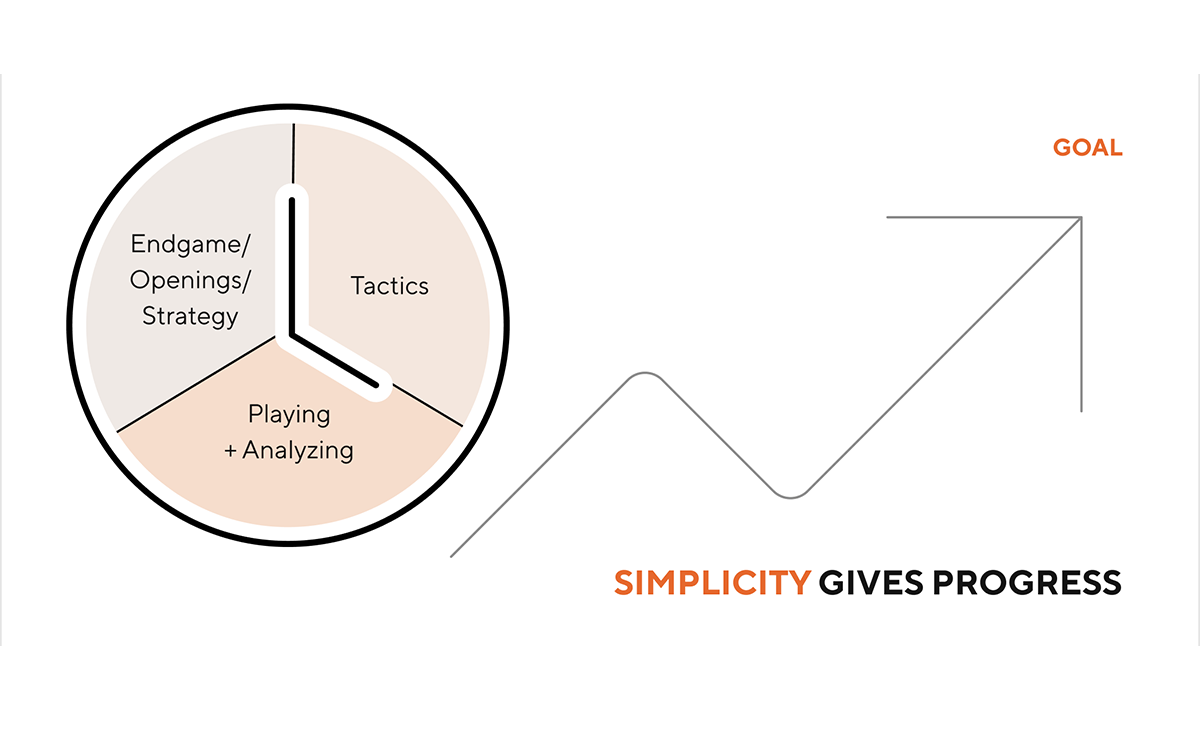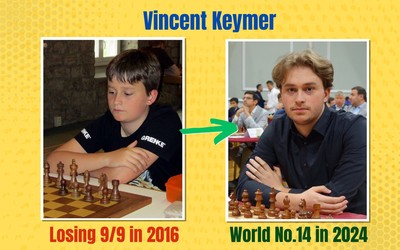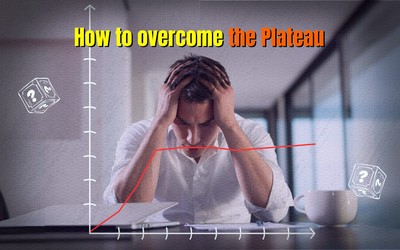
The Three Essential Chess Training Metrics You Need To Track
We are a few months in, and this is a good time to assess your chess Training in 2024.Assuming you have established some sort of a training routine, here are three metrics you should track to know if you are doing well:
- Successful Training Days
- How many % of my games am I analyzing?
- How often do I solve difficult positions?
This blog explains Why & How.
Simplify Your Training
I’m not a big fan of super complicated spreadsheets. Instead, I’m always trying to find the 20% that makes the difference (Pareto Principle). If you break down good chess training, a lot comes down to:
- Actually doing the work
- Learning from your own mistakes
- Improving your tactical skills
If you do those well and often, I’m fairly sure you will improve in the long run. If you don’t, prepare yourself for a plateau.
Sure, there are so many other metrics to keep track of, but for simplicity’s sake, I will focus on those three exclusively in this Newsletter. You will be in the top 90% of chess improvers if you get this right. That should be enough for now.
Chess Training Metric #1: Successful Training Days
The basics. Are you really training when you set out to do so?
For each planned training day, there is a binary answer:
- Yes, I did my training
- No, I didn’t do my training
Nobody is perfect. Don’t expect to be at 100%. But anything below 50% is alarming. My grading would be:
- 80-100%: Good job! You are realistic and putting in the work.
- 50-80%: Decent. But missing days is a weekly occurrence. How can you make sure you do training when you plan to do so?
- 0-50%: Alarming. Be more realistic with your plans. Aim for 100% in the next week, only then slowly increase the days and amount of time you train.
It is better to plan three sessions a week and do great training than planning six long sessions and failing on two days.
Once missed training sessions become a habit and not an exception, it won’t be long until you don’t have any study routine anymore.
Quality > Quantity!
Chess Training Metric #2: How Many % Of My Games Am I Analyzing?
This is as simple as painful (probably). Many of us sadly have the horrible habit of playing games without learning from our mistakes. In terms of chess improvement, that is a huge missed opportunity and danger.
You will make the same mistakes several times and not even realize it.
Soon your mistakes become second nature, and it will be nearly impossible to get rid of them. that you’ll have a super hard time getting rid of them in the future. This is how you can invest time in chess and actually get worse, not better.
So, gather all the games you played this year so far and compare that to the amount of games you analyzed.
If you don’t know how to analyze your own chess games, check out my in-depth guides on it (Classical games, Online/Faster games).
Optimally, your number should be close to 100%. Again, perfectionism doesn’t help. But analyzing your games should be a habit, not an occasional occurrence.
Here is my breakdown:
- 75-100%: You are doing amazing. Keep going.
- 50-75%: Above average for sure. What can you do to make this number exceptional?
- 25-50%: Meh. Include analyzing your games in your training plan. Otherwise, you might feel as if you don’t have time for it.
- 0-25%: That’s really concerning. Your actions don’t back up your ambitions of improving your game. Take radical action to get up to 50% ASAP.
Chess Training Metric #3: How Often Do You Solve Tough Positions?
Reading books, watching videos, playing through Master games, all these things are nice and help you improve a little.
What really makes a difference is trying to solve difficult positions.
The reason for this is simple. While playing games, you will face new positions that are hard to crack without being able to access help.
Solving difficult positions is the ultimate way of training for the competition.
If you always have an engine, book, or teacher by your side in training, you will feel smarter and stronger but fail to convert this into games.
For the third metric, look at how often you’ve solved difficult positions with good focus. In this case, 100% would actually be bad. I’m a big fan of tactics, but there are other parts in Chess Training you shouldn’t totally neglect.
If you follow my 1/3 Rule, you will be at 33%. You might argue that playing in itself is solving difficult positions. In that case, if you always play with good focus and follow the 1/3 rule, you’ll be at 66%.
 The 1/3 Rule: Spend time on what really matters.
The 1/3 Rule: Spend time on what really matters.
Here is the breakdown:
- 66-100%: I appreciate your effort, but you might slow down a little. Are you sure you do the solving with the right intensity?
- 33-66%: You are doing great. You focus on what matters most but do not completely neglect the rest.
- 10-33%: Not so great. I know it is hard, and that is the point. Try adding another tactic-solving session to your training plan.
- 0-10%: Huge alert. You might acquire knowledge, but your skills and, thus, results probably are the same. If you want to break through a plateau, you need to do some more solving. Now.
Especially if you are in the lower percentages and try to ramp up massively, keep in mind that only well-done training should count as such.
In a nutshell:
- Avoid the try & error method
- Always write down your solution before executing moves/checking with the book solution.
- Put yourself under time constraints to imitate a real game.
Find my complete guide to solving puzzles the right way here.
How Has Your Training Been In 2024?
So, how would you rate your own training in 2024 so far?
I’m a big fan of looking reality in the eye. But that doesn’t mean you should be too harsh on yourself if things haven’t gone well so far. Life gets in the way. We all experience that.
So, big congrats if you are above average in both metrics. Take a moment to be proud of yourself. Get yourself something you like, or take a day off.
And then keep going and check back in every month to see if you keep the pace up.
If you are in the lower parts for one or more metrics, the only way out is action. Ask yourself:
How can I improve my training one step at a time?
Pick the most important metric (if you don’t train at all, that would be a good place to start, don’t you think so? :)) to work on and focus on that for a while. When your numbers are better, you can focus on the next one.
You still have many months in 2024. Not all is lost. But it is time to get into good routines. Right now.
Keep improving,
Noël
This article was originally posted on my own Blog, NextLevelChess.
Click here to read more similar articles.
Whenever you're ready, there are three ways I can help you:
- Get my Free eBook, The Art of Chess Training. It teaches you all you need to know to start training in a structured, efficient way.
- Are you below 1400 Lichess? Then my new course, Beginner Chess Mastery, is perfect for you. Learn all the fundamentals and get a free White + Black Opening Repertoire. Learn more here.
- Last but not least, you can get more Chess insights by signing up for my free Friday Grandmaster Insights Newsletter. Join 16,000+ chess enthusiasts here.
More blog posts by NoelStuder

How to Transform 0/9 into World #14
What would you do after losing 9 games in a row? Cry? Quit Chess? Talk about how unlucky you are?
Adult Improvers: Why GM Openings Might Not Suit You
A 1750-rated reader recently told me: “A small comment to my Grandmaster Coach about not fully under…
How To Overcome A Plateau In Chess Improvement
“After our last session, I had trouble walking straight for 2 days, it felt like I re-lived the symp…